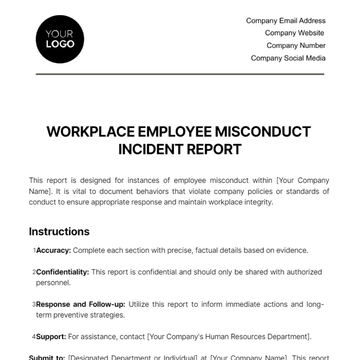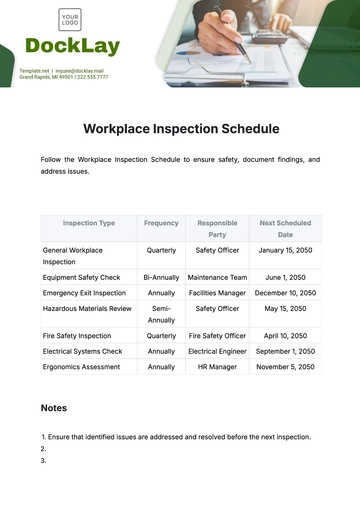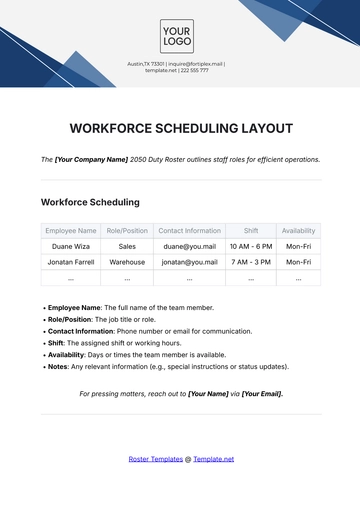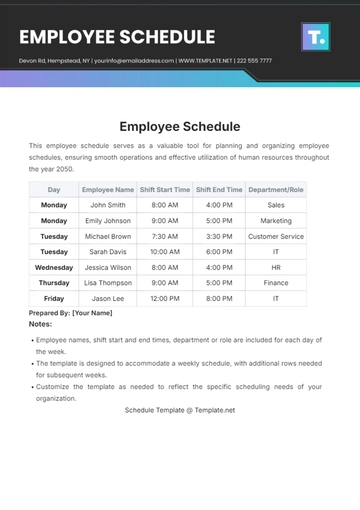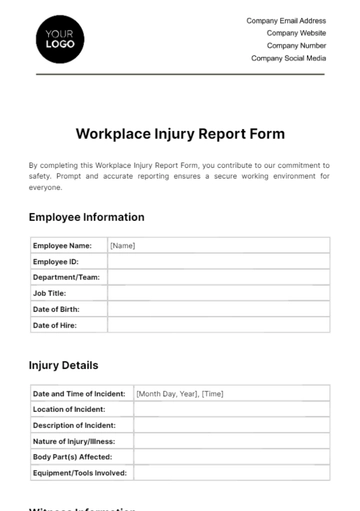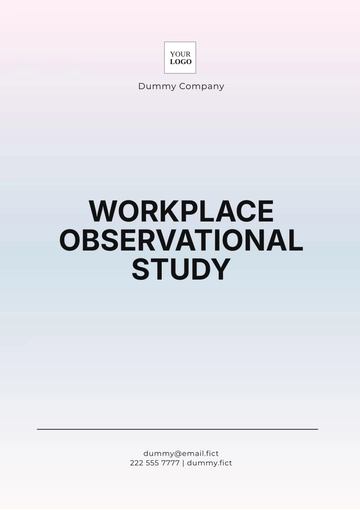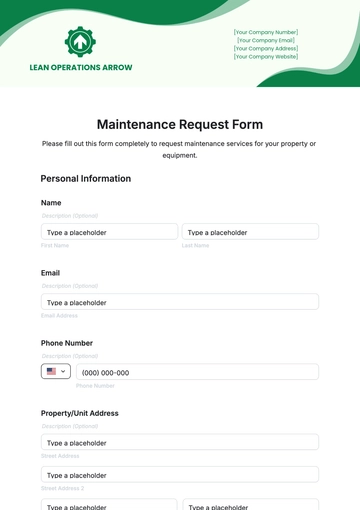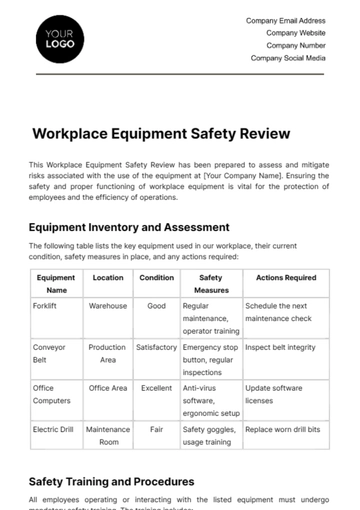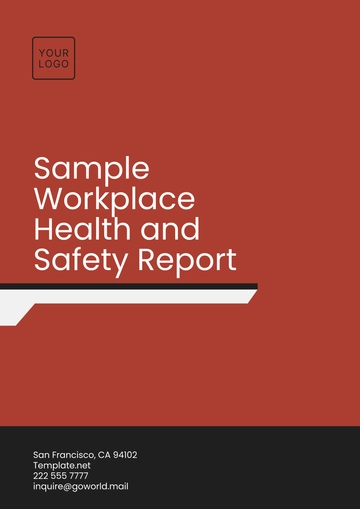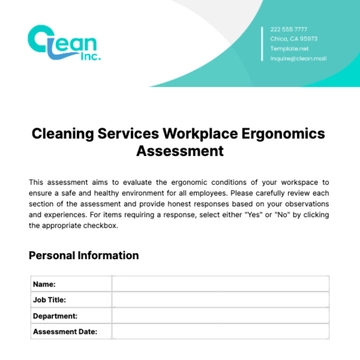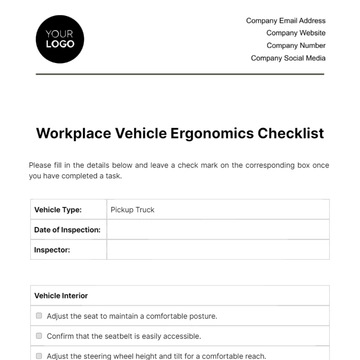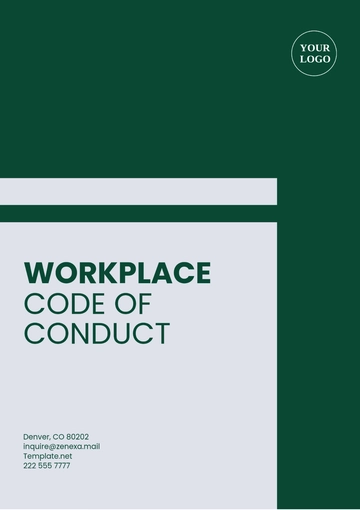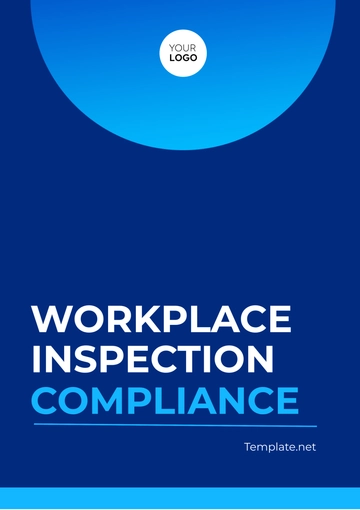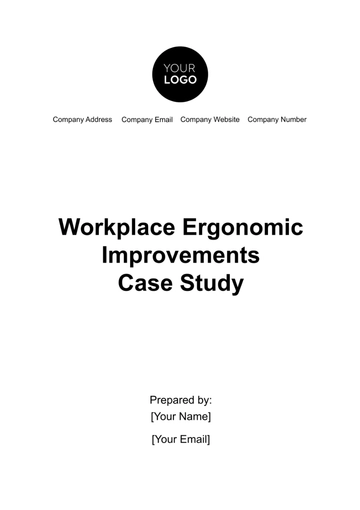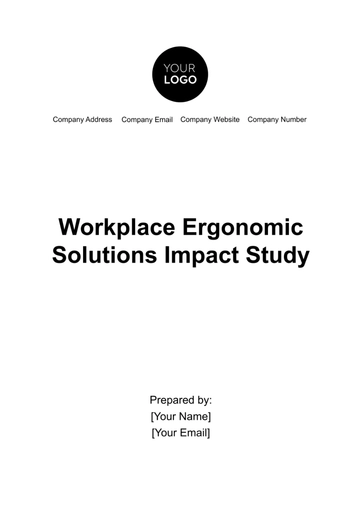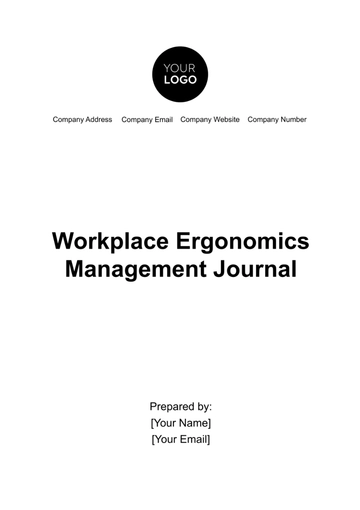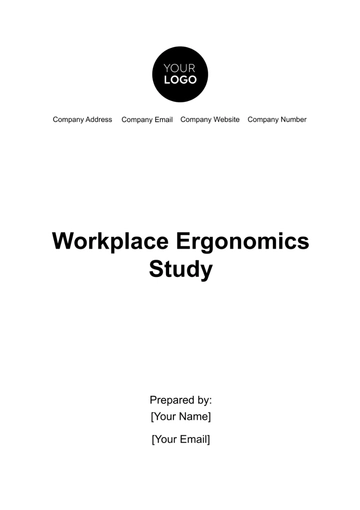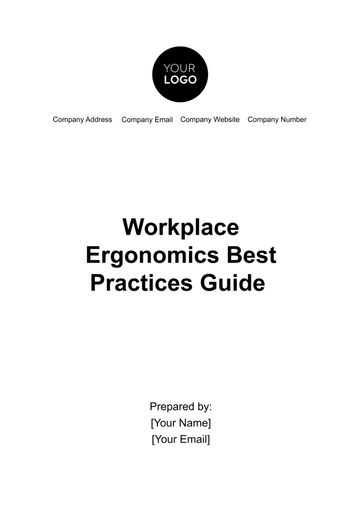Free Workplace Ergonomics Improvement Study
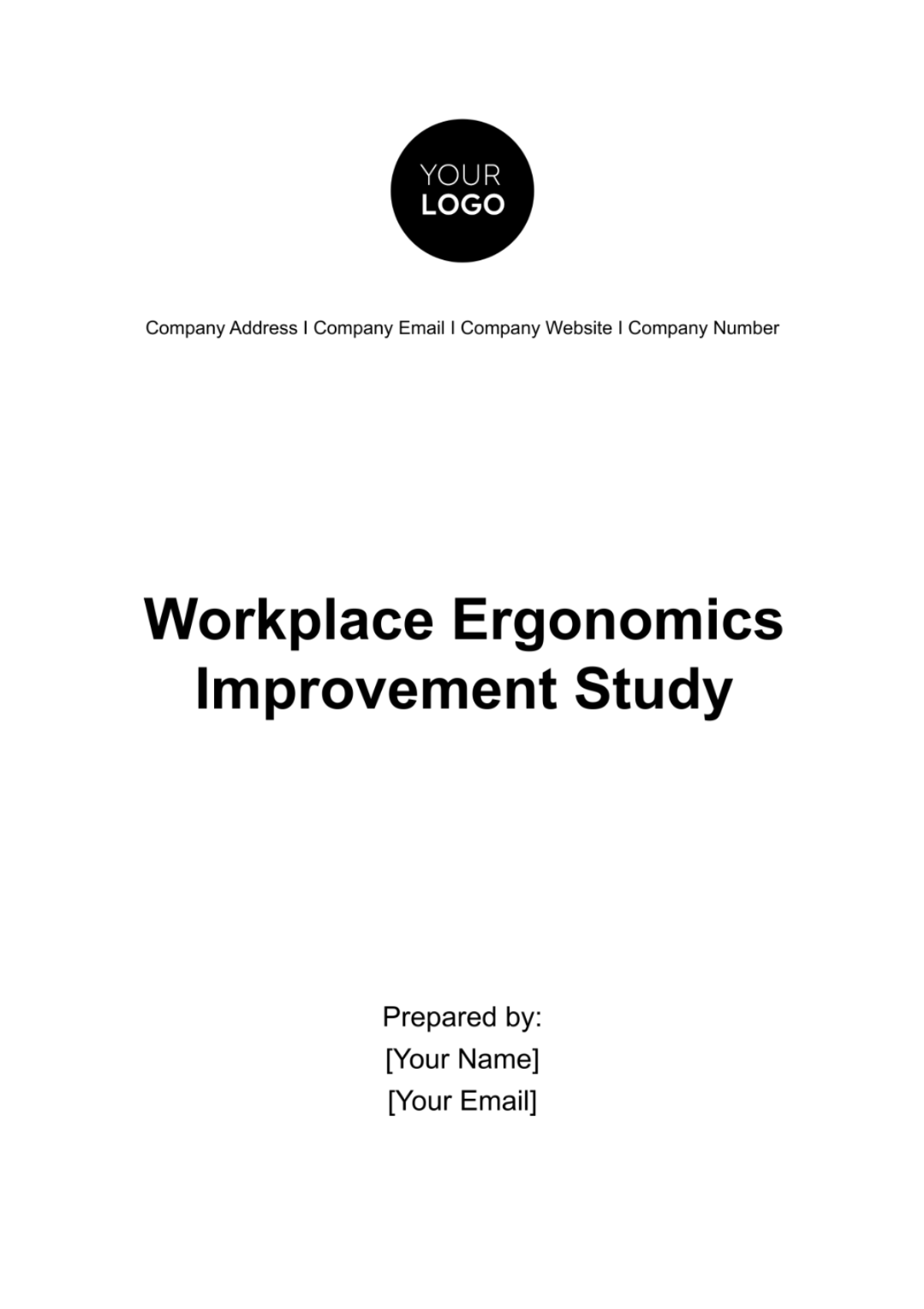
I. Executive Summary
A. Brief Overview
This Workplace Ergonomics Improvement Study was conducted to assess and enhance the ergonomic conditions within [Your Company Name]. The study aimed to identify potential hazards, analyze current ergonomic factors, and propose recommendations for improvements.
B. Purpose of the Study
The primary purpose of this study was to create a safer and more comfortable working environment for employees, reduce the risk of musculoskeletal disorders, and enhance overall productivity.
C. Key Findings
Suboptimal workstation design and layout.
Inadequate ergonomic furniture and equipment.
Poor lighting conditions contributing to eye strain.
Limited awareness among employees regarding proper ergonomic practices.
D. Recommendations
Redesign workstations with ergonomic furniture.
Provide adjustable chairs, keyboards, and monitor stands.
Implement improved lighting fixtures.
Conduct regular ergonomic training programs for employees.
II. Introduction
A. Background Information
[Your Company Name] recognizes the importance of employee well-being and aims to create a work environment that promotes health and productivity. Ergonomics is a key aspect of achieving this goal.
B. Objectives of the Study
Identify existing ergonomic challenges.
Assess the impact on employee health and productivity.
Propose practical recommendations for improvement.
C. Scope and Limitations
The study focused on office workstations within the corporate headquarters. Manufacturing and specialized workstations were excluded from this assessment.
D. Importance of Ergonomics in the Workplace
Ergonomics is critical for preventing work-related injuries, enhancing job satisfaction, and optimizing employee performance. A well-designed ergonomic program contributes to a healthier and more productive workforce.
III. Methodology
A. Data Collection
Through a combination of observational assessments, employee surveys, and ergonomic workstation evaluations, the data collection approach aimed to provide a comprehensive understanding of the current situation within our organization, identifying areas for improvement to enhance employee well-being, productivity, and overall workplace satisfaction.
Ergonomic Assessments: Conducted by certified ergonomics specialists.
Employee Surveys: Gathered feedback on discomfort and preferences.
Work Process Analysis: Observed key tasks and identified repetitive motions.
B. Participant Selection
A representative sample of employees from various departments participated in the ergonomic assessments and surveys.
C. Tools and Instruments Used
Ergonomic assessment tools.
Survey questionnaires.
Video recording for work process analysis.
D. Timeline of the Study
The study was conducted over a four-week period, including one week of pre-assessment preparation, two weeks of data collection, and one week for analysis and report compilation.
WEEK | TASKS | FINDINGS |
[Week 1] | Conduct initial ergonomic assessments of workstations. | Identified common ergonomic concerns, such as discomfort in the neck, shoulders, and lower back. |
[Week 2] | Perform detailed evaluations of individual workstations based on initial findings. | Discovered specific issues related to desk height and keyboard placement. |
[Week 3] | Conduct ergonomic training sessions to educate employees on proper posture and workstation ergonomics. | Improved awareness of proper ergonomic practices among employees. |
[Week 4] | Distribute follow-up surveys to gauge the effectiveness of implemented changes. | Positive feedback regarding reduced discomfort and improved overall well-being. |
The timeline showed the efficacy of targeted interventions in enhancing employee comfort and productivity. Ongoing efforts, including periodic assessments and employee education, are recommended to sustain these positive changes and foster a healthier work environment.
Current Ergonomic Conditions
The study revealed a range of ergonomic conditions within our workplace. A series of employee surveys provided valuable insights for us to move forward.
A. Workstation Layout and Design
Findings:
Workstations are arranged in a fixed layout.
Limited flexibility for adjusting desk height and monitor positions.
Recommendations:
Introduce sit-stand desks for flexibility.
Implement a modular workstation layout for customization.
B. Furniture and Equipment
Findings:
Chairs lack lumbar support.
Keyboards and monitors are not adjustable.
Recommendations:
Provide ergonomic chairs with lumbar support.
Supply adjustable keyboards and monitor stands.
C. Lighting Conditions
Findings:
Insufficient natural light.
Inconsistent artificial lighting.
Recommendations:
Install full-spectrum lighting for a natural feel.
Adjust lighting levels based on workstation tasks.
D. Noise Levels
Findings:
Open office layout contributes to high noise levels.
Lack of noise-canceling measures.
Recommendations:
Consider acoustic panels to minimize noise.
Establish designated quiet zones.
Work Processes and Tasks
Findings:
Repetitive motions during data entry tasks.
Inadequate breaks for tasks requiring sustained concentration.
Recommendations:
Introduce ergonomic accessories to reduce repetitive strain.
Implement regular breaks for tasks with extended durations.
Employee Feedback
Findings:
Limited awareness of proper ergonomic practices.
Some employees experience discomfort but hesitate to report it.
Recommendations:
Conduct regular training sessions on ergonomics.
Establish a confidential reporting system for discomfort.
V. Ergonomic Risk Assessment
The study identified key risk factors contributing to employee discomfort. The assessment informed targeted interventions, emphasizing on the importance of ongoing efforts to mitigate ergonomic risks and maintain a healthier, more comfortable workplace environment.
A. Identification of Potential Hazards
Findings:
Potential hazards include awkward postures and repetitive motions.
Recommendations:
Implement hazard control measures.
Encourage reporting of hazards through a proactive reporting system.
B. Evaluation of Physical Stress Factors
Findings:
Employees experience stress due to discomfort.
Increased stress correlates with lower job satisfaction.
Recommendations:
Address physical stress factors through ergonomic improvements.
Incorporate stress management programs.
Analysis of Repetitive Motions
Findings:
Repetitive motions are prevalent in data entry tasks.
Increased risk of musculoskeletal disorders.
Recommendations:
Provide ergonomic accessories to reduce strain.
Rotate tasks to minimize repetitive motions.
Assessment of Posture-related Issues
Findings:
Poor posture due to non-adjustable furniture.
Increased risk of musculoskeletal issues.
Recommendations:
Provide ergonomic chairs and adjustable workstations.
Educate employees on proper posture.
VI. Employee Health and Well-being
The well-being of employees is paramount to organizational success. Prioritizing employee health not only enhances productivity but also fosters a positive workplace culture.
A. Impact of Current Ergonomic Conditions on Health
Findings:
Increased reports of musculoskeletal discomfort.
Absenteeism related to ergonomic issues.
Recommendations:
Conduct health assessments for affected employees.
Implement ergonomic improvements to reduce health impacts.
B. Trends in Work-Related Injuries or Discomfort
Findings:
Increased reports of discomfort and injuries over the past year.
Some employees are unaware of available support and reporting mechanisms.
Recommendations:
Establish a clear reporting process for injuries and discomfort.
Enhance communication about available support services.
C. Absenteeism and Productivity Issues
Findings:
Absenteeism rates are higher among employees experiencing discomfort.
Reduced productivity in areas with known ergonomic challenges.
Recommendations:
Implement ergonomic improvements to reduce discomfort and absenteeism.
Monitor productivity metrics following ergonomic interventions.
VII. Recommendations for Improvement
The study offers key recommendations for enhancing employee well-being. By implementing these recommendations, [Your Company Name] can sustain positive changes, mitigate ergonomic risks, and create a healthier and more comfortable work environment for its workforce.
A. Ergonomic Furniture and Equipment
Procure ergonomic chairs with lumbar support for all employees.
Provide adjustable desks to accommodate sitting and standing preferences.
Supply adjustable keyboards and monitor stands for customization.
B. Workspace Layout and Design
Redesign workstations to allow for modular layouts.
Establish designated quiet zones for focused work.
Introduce flexible seating arrangements to promote movement.
C. Lighting, Noise, and Environmental Adjustments
Install full-spectrum lighting fixtures to mimic natural light.
Implement acoustic panels to reduce ambient noise.
Adjust lighting levels based on workstation tasks.
D. Training Programs for Employees
Conduct regular ergonomic training sessions for all employees.
Provide educational materials on proper ergonomic practices.
Establish a confidential reporting system for discomfort and ergonomic concerns.
E. Integration of Ergonomics into Work Processes
Introduce ergonomic accessories for tasks involving repetitive motions.
Implement a task rotation schedule to minimize repetitive strain.
Integrate ergonomic considerations into the planning of new work processes.
VIII. Implementation Plan
These targeted interventions that the study found aim to sustain positive changes, reduce ergonomic risks, and build a healthier and more comfortable workplace for sustained well-being.
A. Prioritization of Recommendations
Immediate: Procurement of ergonomic chairs and accessories.
Short Term (3-6 months): Redesign of workstations and installation of lighting fixtures.
Medium Term (6-12 months): Implementation of training programs and task rotation schedules.
B. Responsible Parties
Facilities Management: Redesign of workstations and installation of lighting.
Human Resources: Procurement of ergonomic furniture and implementation of training programs.
Occupational Health and Safety: Oversight of overall implementation and monitoring.
C. Timeline for Implementation
Month 1-2: Procurement and installation of ergonomic chairs and accessories.
Month 3-4: Redesign of workstations and installation of lighting fixtures.
Month 5-6: Implementation of training programs and task rotation schedules.
Budgetary Considerations
Ergonomic furniture and accessories: [$15,000]
Workspace redesign and lighting fixtures: [$10,000]
Training programs: [$800]
Communication Plan
Email communication to all employees.
Intranet updates and announcements.
Training sessions with department representatives.
IX. Monitoring and Evaluation
The process that the study deduced aims to continuously optimize ergonomic interventions and uphold a healthy workplace environment.
A. Key Performance Indicators (KPIs)
Reduction in reported discomfort.
Decrease in absenteeism rates.
Improvement in productivity metrics.
B. Regular Follow-up Assessments
Monthly check-ins for the first three months.
Quarterly assessments thereafter.
C. Employee Feedback on Implemented Changes
Surveys and feedback sessions.
Anonymous reporting system for ongoing concerns.
D. Continuous Improvement Strategies
Periodic ergonomic refresher training.
Ongoing monitoring of KPIs and adjustment of interventions as needed.
Regular updates to the ergonomic program based on employee feedback.
X. Conclusion
This Workplace Ergonomics Improvement Study outlines crucial findings and actionable recommendations to enhance the work environment at [Your Company Name]. By addressing workstation design, furniture, lighting, and employee education, the proposed changes aim to reduce discomfort, mitigate health risks, and boost overall productivity.
- 100% Customizable, free editor
- Access 1 Million+ Templates, photo’s & graphics
- Download or share as a template
- Click and replace photos, graphics, text, backgrounds
- Resize, crop, AI write & more
- Access advanced editor
Introducing our Workplace Ergonomics Improvement Study Template, exclusively crafted by Template.net. This editable and customizable tool is designed to streamline your ergonomic assessments effortlessly. Tailor-made to suit your needs, it's editable in our Ai Editor Tool, ensuring seamless customization. Elevate your workplace comfort and productivity with ease.
